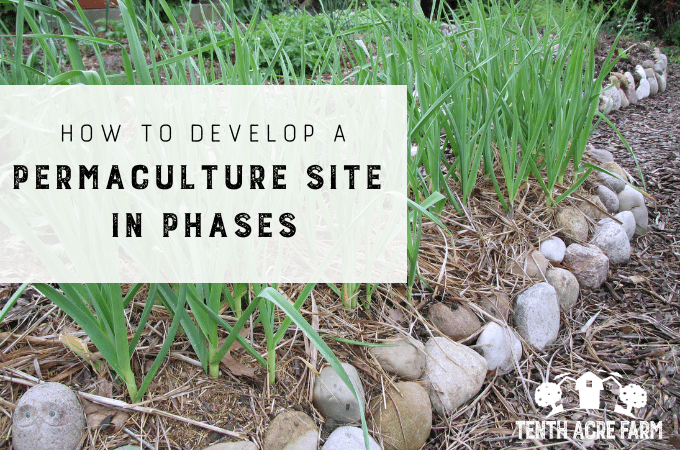The process of designing an efficient site is like putting together a puzzle. By drawing these six maps, you can create a permaculture design that maximizes your efforts for a low-maintenance garden, landscape, or whole site.

This page may contain affiliate links. Please read my disclosure for more info.
In this article:
- Is drawing permaculture design maps just extra work?
- What are 6 essential maps to draw for permaculture site design?
- Should I hire a permaculture designer or DIY my site design maps?
- How to collect existing maps of your site
- What is a permaculture base map?
- What is a permaculture sun map?
- What is a permaculture sector map?
- What is a permaculture zone map?
- What is a permaculture master plan map?
- What is a permaculture water map?
- 4 FAQs about drawing permaculture site design maps
Permaculture is a system for designing agricultural landscapes that are ecologically sound. The aim is working with nature to be low maintenance and highly productive.
Read more: What is Permaculture? Designing a Resilient Garden
Permaculture site design follows a multi-step process, which starts with observing the landscape through a specific set of both passive and active observations. First, you may want to get acquainted with how to use the power of passive observation with a 10-step exercise.
In this article, we’re going to focus on active observations, by reviewing six essential maps to draw. You’ll learn how to collect data about your site through research and plot it on physical maps of the property.
These maps give you a visual representation of all the data points that can affect design decisions, and are the bread-and-butter of a permaculture design. They help you think through many possible scenarios and outcomes before you commit to certain strategies or concepts. By working with the unique characteristics of your site, you can more effortlessly achieve your goals.
Drawing maps isn’t just extra work
Personally, I’ve been practicing permaculture design for over 10 years, and I have a pretty good idea of how I want my new home site to look when I’m all done developing it. So you’d think I might be able to skip all this mumbo jumbo and just dig in.
But I didn’t. I still drew all the maps. I didn’t skip a step, even when I wanted to.
And you know what? I discovered some things in the process—things I wouldn’t have thought about until it was too late, things that would have cost me a lot of time to go back and fix.
Believe me, if it seems like drawing maps is a waste of time, it won’t be. But you’ll never know until you give it a try. 🙂
If you’d like to take a permaculture design course, here are some pointers.
Permaculture is like baking a batch of cookies
The way we put components together in a design determines whether or not it will work.
For example, if you want to make cookies, first, you locate a recipe (design). The recipe creator has thought through all kinds of scenarios—which ingredients (components) to include, how much of each, and in what order to add them.
If the recipe is followed, the result is usually a delicious batch of cookies.
We’ve all made recipes and mistakenly did the steps out of order. Sometimes we’ve even accidentally omitted an ingredient (component). Much of the time, this spells disaster, and all of our efforts (and cost of ingredients) are a waste.
Sometimes you have to spend a bunch of extra time fixing what went wrong or starting over completely.
Perhaps this isn’t the best example, because even a cookie gone wrong will usually taste pretty good. But you get the idea! 🙂
When you start with a design (recipe), it is simply a starting point, but it is an essential starting point. This is the essence of the permaculture site design.
Once you dive in, you might discover that by skipping a step or combining steps, you could make things more efficient. But without a starting site design, you’re just winging it, and this can lead to wasted time and/or other resources.
Tired of generic permaculture design advice that you can’t apply to your specific goals? If so, check out my Permaculture Design Program and get the tools and support needed to create and implement your own permaculture design.
6 Essential Maps to Draw for the Permaculture Site Design
These six maps are the ones that I feel are essential for developing a permaculture design that meets your needs:
- The base map
- The sun map
- The sector map
- The zone map
- The Master Plan
- The water map
I’ll go over each in detail below.
Hiring a Professional Designer vs. DIY
Hiring a designer can be a great way to bounce ideas off of an experienced professional, and get professionally designed maps in the process. If you would like to hire a professional designer to do this work for you, read this first.
Do It Yourself
I’m pretty low tech, so I drew my maps by hand. I believe this is the most accessible way to create maps. Almost anyone can draw on paper!
Conversely, tech-savvy folks will be able to generate maps on the computer. This makes it easy to move components around when you’re experimenting with their placement, or click “undo” if you mess up. If you know the computer program well, you’ll generate maps pretty quickly.
Changing your mind with a design on paper requires you to draw it all over again.
What’s important is that you follow a process so that the essential factors of a permaculture site design are considered.
Frequently Asked Question: Can I use this process if I’ve already started developing my site?
Yes! You can walk through these steps as if your site wasn’t developed to see how (or if) it is different from what you currently have. Or you can map your site as it is, and improve using the existing placement of components. It all depends on how permanent the existing components are.
Either way, the maps can help you consider changes you could implement to make your existing site more efficient, biodiverse, and low maintenance.
Let’s get started!
Pre-Design Step: Collect Maps of your Site
Before drawing your 6 essential maps, you need to get a few existing maps of your site to draw from. I found google maps really helpful. I also received maps for free from my local Ohio Soil and Water Conservation District (Department of Agriculture) as well as the Ohio Division of Forestry (Department of Natural Resources).
Every state is different as far as services offered to the public, and indeed for international readers, you’ll have to do some sleuthing to find good maps.
Here is the map that was the most useful for my permaculture site and this exercise:

This is a contour map (essential for this exercise).
With some trial and error, I scaled this up to the full size of an 8.5 x 11 piece of paper. It will work in your favor if you can do the same. Edited to add: Recently I learned how to import images into Notes on the iPad, and it’s super easy to “draw” on it and save the image as your map.
Would you like to grow food in your front yard without sacrificing curb appeal? Check out my mini guide, The Permaculture Inspired Edible Landscape.
#1: Base Map for the Permaculture Site Design
The base map is the starting point before developing your site for agricultural pursuits.
To get my base map, I put tracing paper over the image above, and traced the outline of the site, as well as the essential, immovable features such as the house, driveway, and creek.
Indicate north (if you’re in the northern hemisphere) as well as a distance scale.
With this starting point you can brainstorm about how best to use this space.
Here is a look at my base map, my starting point:

This is my base map.
#2: The Sun Map for the Permaculture Design
To plan food-growing areas, you’ll want to find where the sunniest spots are as well as the shade.
Although you can make some guesses by simple observation, mapping can result in amazing realizations. For example, I discovered that I have a bit more sun in my backyard than I originally thought.
Plot full sun (6+ hours), partial sun (3-6 hours), and full shade (less than 3 hours) areas on the map at your summer solstice (June 21st in the northern hemisphere).
Here are two low-tech ways to map the sun without any equipment or devices:
I use an app on my smart phone called Sun Seeker (available for iPhone or Android). With this app I can see from any location exactly where the sun will be in the sky during any of the solstices or equinoxes.
I used 11 locations around my yard to map exactly where I would get full sun to full shade. I took measurements of each spot and its distance from the house. Having another person to manage the other end of the tape measure is a big help. Then I plotted those distances on my map.
Here is how my sun map turned out:

My Sun Map
Would you like to learn more about using permaculture to improve the biodiversity of your garden, reduce maintenance, and increase yield?
You’ll find loads of information like this in my award-winning book, The Suburban Micro-Farm.
#3: The Sector Map for the Permaculture Design
Sectors are those elements you don’t have much control over. You can enhance or redirect them, but you can’t usually put an end to them all together.
Some examples (in no particular order) are:
- Contour: Contour lines tell us where land slopes and where gravity sends water to drain.
- Wind: We can’t help where wind comes from, but we can buffer it.
- Noise: Most of us have to deal with some noise that is out of our control such as a busy road or a neighbor with a yappy dog.
- Sunlight: Include the effects of neighboring trees as well as your own.
- Snow/Fire: If these are common for you, map what direction they might come from so you can buffer their effects.
- Wildlife: Map wildlife patterns that are significant challenges. I’ve mapped the most popular deer route on my map below.
- Flooding/Drainage: Demonstrate how water moves on your site according to the contour lines and seasonal flooding.
- Views/Privacy: Mark where you’d like to improve or retain privacy plantings, and where you can enhance beautiful views.
- Crime: What direction might thieves or unwelcome folks come from? Certain components may help to reduce the threat.
- Air/Water/Light Pollution: A neighbor with a flood light, a neighboring farmer who sprays his/her crops, etc…
Identifying these sectors can help you brainstorm ways to minimize their effect or find a way to turn the problem into an asset (i.e. buffered winds become gentle breezes in growing areas with hedgerows, a neighbor’s errant downspout feeds a swale or rain garden on your side of the fence).
Only map the sectors above that are significant to your site.
Here’s a look at my sector map:

My Sector Map
#4: The Zone Map for the Permaculture Site Design
Zones help us think about how to use different areas of a site for growing, sitting, storing materials, etc.
Permaculture zones range from 0-5, with zone zero being inside the home, and zone 5 being farther away untouched wilderness.
How many zones a permaculture site has depends on how large it is and how it is situated. Although a site can have up to five zones, for example, the original Tenth Acre Farm on 0.10 acres only included zones one and two.
The following is a rough outline of how zones are used. Zone:
- 1: Closest to the house and the most intensively used space. Where intensive gardening occurs; where paths lead to doors.
- 2: A bit farther from the house but is still an essential part of daily life. Small livestock, edible perennials, compost, etc.
- 3: Farther out still, visited regularly for components that don’t require as much attention: staple crops, orchards, pasture.
- 4: Borders on wilderness: Managed woodlands for timber, nut crops, foraging, wildlife, pasturing large livestock.
- 5: Wilderness with no human intervention: Wildlife moves freely, humans go for quiet respite or hunting.
Zones are fluid and are adaptable for each site’s unique characteristics.
For example, my new homestead, Tenth Acre Farm at Twisted Creek, is a little over 3 acres. It includes all five zones. The slope and forest make much of it unreasonable for development (zones 4 and 5).
On the other hand, a different 3-acre site that is flat, cleared, and mowed will not have all five zones unless some of the areas are intentionally reforested or left to go wild.
Here is what my zone map looks like:

My zone map.
Would you like to yield delicious harvests while partnering with nature? Check out my mini guide, The Permaculture Inspired Vegetable Garden.
#5: The Master Plan (Map) for the Permaculture Site Design
The master plan is your long-term vision for your site. It is a culmination of your observations and discoveries from the previous maps.
Master Plan Step A:
Make a list of everything you want to include in your permaculture site design. This will be everything from vegetable garden to compost to chicken coop: Realistic things that you actually want.
Master Plan Step B:
Place tracing paper over your base map and experiment with placing the components from Step A onto your site. This is called a schematic design. Don’t worry about getting it right—that’s why you’re using tracing paper.
Draw at least four different schematic designs, each time situating the components in different positions or locations.
Push the limits of what you think is possible. This is often when ‘aha’ moments happen. Is there a full-sun area in zone one where your vegetable garden could be placed that you hadn’t thought of before? Could a shed be rotated to be more accessible from the garden or allow space for a greenhouse?
Final Master Plan Map
Decide which ideas will be the most practical, efficient, and low maintenance. The final site design is usually a hybrid of ideas from the four schematic designs in Step B above. Keep working until you’re satisfied with the layout, then sketch it onto paper for your final Master Plan.
The master plan is your big-picture vision. It shows components like a food forest, but it won’t show exactly what you intend to grow there. Those details come later.
A ‘final’ master plan, in actuality, isn’t final.
Rather, it IS a starting point for creating an ecologically sound, low maintenance, productive homestead.
The best way to see a master plan in action is to take a look at mine:

My master plan for Tenth Acre Farm at Twisted Creek.
You can see that I’ve created a convenient “activity center” next to the vegetable garden, which includes a variety of useful structures and access to materials. Having them grouped together saves time. Although I would’ve liked to place the food forest near this work area as well, there wasn’t enough sun in the backyard to accommodate it.
Therefore, I placed it in the front yard at the edge of the woods, where the sunlight is bountiful. It won’t be visited nearly as often as the vegetable garden, so that’s why I chose to move the food forest away from the “activity center”.
#6: Water Map for the Permaculture Site Design
This is where you want to think strategically about the water on your site: Where does it come from and where does it go? Can you capture it and passively irrigate growing areas? Can you take advantage of water from your roof?
Golden Rule: Always create water infrastructure first. Otherwise, you’ll spend a lot of time hand watering, which is neither efficient nor low maintenance.
Here is a look at my water map:

My water map.
The vegetable garden area in my backyard will be tricky to manage as far as water is concerned. That’s because there’s no water spigot on the back of the house. The nearest spigot is 180 feet away, and that’s a lot of hose!
Thankfully, I’m thinking ahead with this exercise. Two downspouts on the house nearest to the garden can direct water to a swale at the top of the vegetable garden. That’s 2,500 gallons of passive, gravity-fed water per year that can majorly reduce work and water infrastructure.
In the garden shed area, I’ll capture water from the roofs of the various structures in containers, and send the overflow through one pipe to the garden swale. I’ve also marked where, in my dream world, I would add running water out to the shed at a spigot.
This map was especially valuable for me to draw, because I couldn’t solve the conundrum of lacking a spigot near the garden. Once I drew it out, I saw opportunities to direct water passively toward the garden from the roofs of the house and the smaller structures.
Read more about permaculture swales.
The Power of Drawing Permaculture Maps
It takes time to think through this process and draw out the maps that lead up to a master permaculture site design. However, much like putting together a puzzle, the final results are overwhelmingly satisfying, inspiring, and calming.
You no longer have to worry whether your homestead efforts are worthwhile. Your big-picture view is an intentional plan to work from to create a low maintenance, ecologically sound, permaculture-designed homestead.
Wondering what to do next? Here’s how to plan phases of development.
Resources
Books referenced for this article:
- Permaculture Design: A Step-by-Step Guide
- Practical Permaculture: for Home Landscapes, Your Community, and the Whole Earth
4 FAQs About Drawing Permaculture Site Design Maps
#1: Can I use this mapping process if I’ve already started developing my site?
Yes. You can walk through these steps as if your site wasn’t developed to see how (or if) it is different from what you currently have. Or you can map your site as it is, and improve using the existing placement of components. It all depends on how permanent the existing components are. Either way, the maps can help you consider changes you could implement to make your existing site more efficient, biodiverse, and low maintenance.
#2: Is drawing permaculture design maps just extra work?
No, it’s not. Without a starting site design, you’re just winging it, and this can lead to wasted time and/or other resources. Once you dive in, you might discover that by skipping a step or combining steps, you could make things more efficient.
#3: What are six essential maps for permaculture site design?
The six essential maps for developing an effective permaculture design are the base map, the sun map, the sector map, the zone map, the master plan, and the water map.
#4: Should I hire a permaculture designer or DIY my site design maps?
Both approaches are valid. Hiring a professional designer provides expert guidance and professionally designed maps. DIY mapping is more accessible and can be done by hand (low-tech) or using computer programs (for tech-savvy individuals). What’s important is that you follow a process so that the essential factors of a permaculture site design are considered.
Have you created maps for your permaculture site? How did they help you meet your goals?
READ NEXT:









Mrs. D says
Fascinating! Thanks for the ideas as we set up our mini farm. =)
Amy says
I’m glad this was helpful for you!
Kathy Partridge says
Probably one of the clearest explanation of the mapping process that I’ve read. I look forward to your chronicles of the actual site development.
Amy says
Thanks, Kathy! I look forward to sharing!
Shayla says
Excellent article with lots of detailed instructions! We close on our house in a couple of weeks and I’m going to try my hand at following your mapping instructions. Much smarter than gardening without a plan! Can’t wait to see how things progress and read your implementation plans.
Amy says
Congratulations on your new house! How exciting!
Noala says
Great article, thanks. Note though that down here in the southern hemisphere we also mark North on maps, not south.
Tessa says
So helpful – thank you! Just now starting a design course and I love looking at as many pictures as I can.
Amy says
Yay! Best of luck!
Rachel says
Where did you find the contour map? We also live in Ohio (outside Columbus) and I visited the websites you mentioned, but didn’t find any helpful maps. Thanks!
Amy says
Unfortunately, the maps aren’t online. You’ll have to contact your local office.
They’re very helpful and will help you find what you need. They’ll be able to find all kinds of old maps of your property to tell you about it’s history, as well. Worth using this free public service!
Aadi Rajpoot says
Wao amazing. i was looking to start a same dream project around 3 acres . this will be very helpfull for me in future. thanks alot, stay blessed
Susan says
This is incredible, thank you for sharing your hard work! One question, did you happen to do this for your first actual 10th acre site? I’d love to see what those looked like as that’s more what I’m working with, it would be helpful to get a view of how to do this (I assume just using zones 1-3 instead of up to 5) but I was just curious if you had those drawings as well. So inspired!
Amy says
The whole system design isn’t available, but you can see an early drawing of my front yard landscape in the conclusion of this article.
Heidi says
Thank you so much for providing these maps for design.
Joel says
Hello Amy, thanks for showing the #6 map plan,
Great work and It has guided me to do mine.
I am designing m y Two Five acre lots in fort saint james in northwest of canada
Cold climate and short seasons, any advice
Thank youvery much
Amy says
I think you’d enjoy taking a look at Ben Falk’s site, and checking out his book, The Resilient Farm and Homestead.
daniel jimenez says
hello! first of all thank you so much for your contribution, it’s really helpful
i have a question, i live in a coastal citie in south mexico, i was wondering if i can also consider the winter solstice in order to have two points of view to map in my solar study, why did you only consider the summer solstice?
Thank you very much again
Amy says
The summer and winter solstices encourage us to observe our site as it changes throughout the seasons with regard to solar access.
At the summer solstice, the sun is at the highest point in the sky, and it is the longest day of the year. The opposite is true for the winter solstice.
A location will have the most solar access and fewest shadows when the sun is at its highest point; fewer hours of sunlight and more shadows at its lowest point.
However, the difference is less dramatic as you move closer to the equator, where sunrise/sunset/solar access are fairly consistent year-round.
Although these solar access points will be more dramatic in northern North America than in southern Mexico, it may still be a helpful exercise for you.
Tessa Zundel says
Thank you for explaining it all so that even I could understand!
Kristin Yoshimura says
Really appreciate the information you share! Thank you!
Betsy Palkowsky says
Thank for the easy to understand explanation of mapping the property. I’m just getting started with our five acre woodlands in southwest Colorado. It’s overwhelming as I’ve been near the gulf coast for years. I’m taking your advice and mapping the land and the plan.